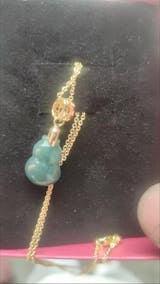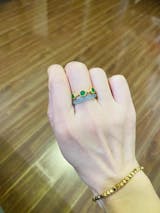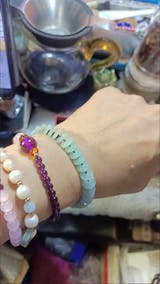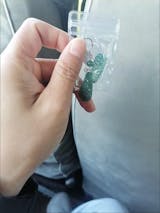Explore the Difference Between Agate Jade and Natural Jade
When it comes to gemstones, few are as revered as jade. Known for its rich cultural history and luxurious appeal, jade is widely used in jewelry and decorative items. However, with the rise of agate jade in the market, many people are confused about the difference between agate jade and natural jade. This article will dive deep into the distinctions between these two stones, helping you understand their unique features and how to identify them.
What is Agate Jade?
Agate jade is a type of agate, a variety of chalcedony, a mineral made of microcrystalline quartz. Though it has "jade" in its name, agate jade is not true jade. It is often dyed or treated to resemble jade, which is why it is frequently confused with the real thing. Agate itself is known for its characteristic banded or layered appearance, and agate jade follows suit, showcasing swirling patterns and multiple colors within its layers.
Key Features of Agate Jade:
- Composition: Agate jade is primarily made up of agate, a form of chalcedony, and is often enhanced or dyed to enhance its color and pattern.
- Appearance: It is typically translucent or semi-translucent with noticeable banding, swirls, or multicolored layers. These patterns are unique, which makes each piece of agate jade distinct.
- Color: The color palette of agate jade can range widely, from vibrant greens to blues, reds, and even purples. Many agate jade pieces are treated with dyes to create these striking colors.
- Hardness: Agate jade is relatively softer compared to natural jade, with a hardness of around 6.5 to 7 on the Mohs scale. This makes it easier to carve but less durable than true jade.

What is Natural Jade?
In contrast, natural jade refers to two distinct minerals: nephrite jade and jadeite jade. These two types of jade are formed under different geological conditions, but both are highly prized for their durability, beauty, and cultural significance.
- Nephrite Jade: This variety of jade is made of amphibole minerals, and its texture is fibrous. Nephrite is more commonly found and is typically more affordable than jadeite.
- Jadeite Jade: This rarer and more valuable form of jade is composed of pyroxene minerals. It is often found in vibrant greens, but jadeite can also appear in lavender, red, black, and white hues.
Unlike agate jade, natural jade is not dyed or treated. Its colors occur naturally, and its texture is smooth and uniform, often with a high degree of translucency.
Key Features of Natural Jade:
- Composition: Natural jade is primarily composed of nephrite or jadeite minerals.
- Appearance: The appearance of natural jade is typically smooth and even, with fewer layers or banding compared to agate jade.
- Color: Natural jade comes in shades of green, white, lavender, yellow, and black. Jadeite, the rarer variety, is often found in vivid greens and is considered the most precious form of jade.
- Hardness: Natural jade is much harder than agate jade, ranking around 6 to 7 on the Mohs scale for nephrite and 6.5 to 7 for jadeite. This makes it more durable and suitable for high-quality jewelry.

What is Agate Jade vs Natural Jade
While both agate jade and natural jade are popular in the jewelry market, there are some key differences between the two:
-
Composition:
-
Agate Jade is a type of agate (chalcedony), a mineral that has been dyed or treated to resemble jade.
-
Natural Jade is a true jade, either nephrite or jadeite, and is mined naturally without any enhancements.
-
-
Appearance:
-
Agate Jade often has distinct banding or swirling patterns, making each piece unique.
-
Natural Jade is typically smooth, with uniform color, though jadeite may have more varied hues, including green, white, lavender, and black.
-
-
Color:
-
Agate Jade can come in a wide range of colors due to the dyeing process, including vibrant hues like red, blue, or purple.
-
Natural Jade's color is limited to natural tones such as green, white, yellow, and lavender. Jadeite, being the rarer form, is typically found in vibrant greens.
-
-
Durability:
-
Agate Jade is softer than natural jade, with a hardness of about 6.5 to 7 on the Mohs scale.
-
Natural Jade is harder and more durable, making it ideal for fine jewelry. Nephrite ranges from 6 to 7, while jadeite can be a bit harder.
-
-
Value:
-
Agate Jade is generally less expensive than natural jade, as it is more abundant and often treated or dyed.
-
Natural Jade—especially jadeite—is highly valuable and considered a luxury item, especially in fine jewelry and traditional artifacts.
-

How to Identify Agate Jade vs Natural Jade
It can sometimes be difficult to tell the difference between agate jade and natural jade at first glance, especially when agate jade is dyed to resemble the vibrant green hues of natural jade. Here are some tips to help you identify them:
-
Look for Banding: Agate jade often has visible banding or swirling patterns. Natural jade, on the other hand, tends to have a smoother, more uniform appearance without any obvious patterns.
-
Examine the Color: Natural jade comes in natural shades, typically in translucent or opaque tones. If the color seems unusually vibrant or too uniform, it may be dyed agate jade.
-
Check the Hardness: If you have access to the stone, you can test its hardness. Agate jade is softer than natural jade, so it will scratch more easily than genuine jade.
-
Seek Professional Evaluation: If you're still uncertain, it’s always a good idea to have the gemstone professionally evaluated. Gemologists can confirm whether you have genuine jade or agate jade.
Conclusion
Both agate jade and natural jade have their place in the gemstone market, each offering unique beauty and appeal. While agate jade is an affordable and colorful alternative to natural jade, the latter remains a prized stone with a rich history and exceptional durability. Understanding the differences between the two can help you make an informed decision when purchasing jade jewelry or decorative pieces. Whether you’re drawn to the vibrant patterns of agate jade or the timeless elegance of natural jade, each stone brings something special to the table.
Explore the elegance and natural beauty of authentic jade—a symbol of purity, prosperity, and lasting fortune.
Related Articles:
How Much Is Jade Worth and the Most Expensive Jade Types
The Meaning and Value of a Jade Buddha Necklace
Why Do People Wear Jade Bracelets: Meaning, Symbolism, and Benefits



























































